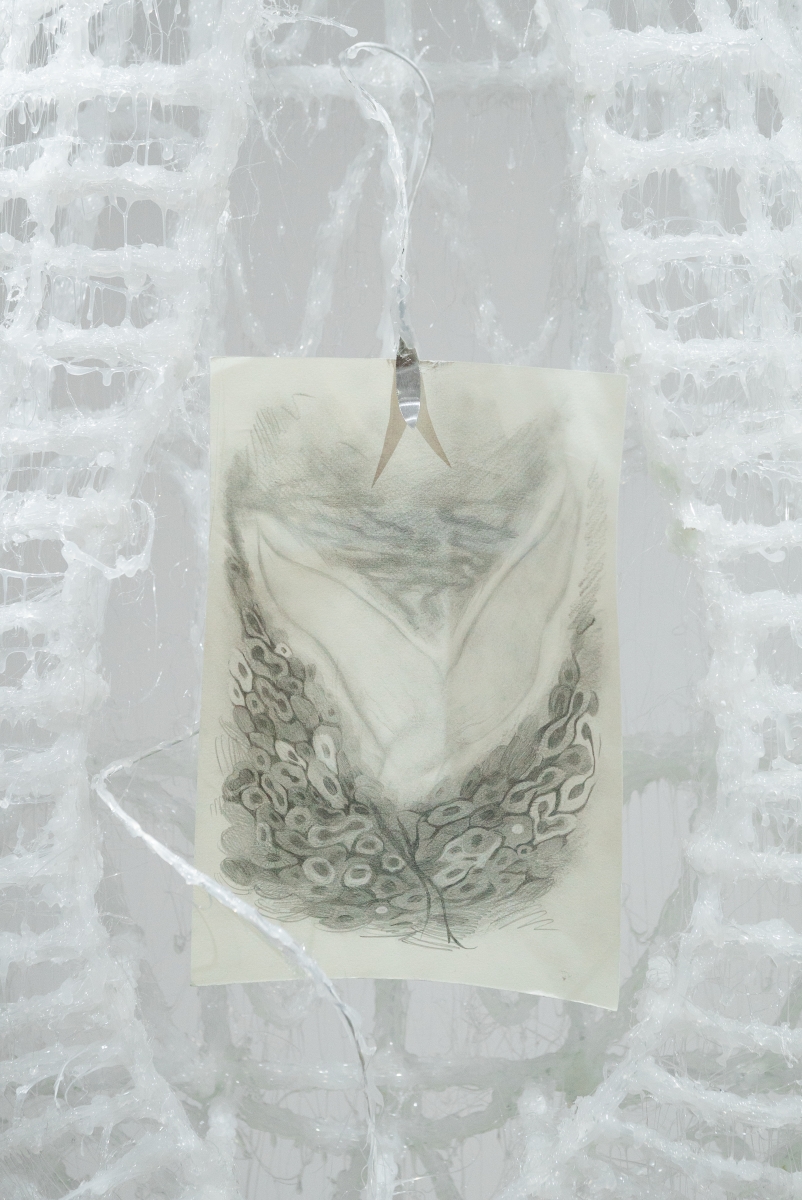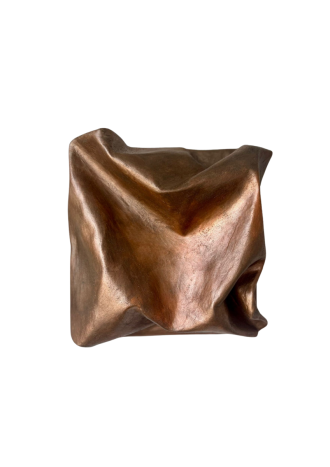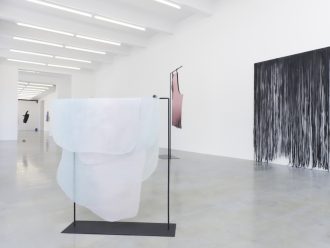‘Self-support Group’, a solo show by the Hamburg-based Lithuanian artist Algirdas Jakas, was due to open on 10 December 2020 at the Vilnius Graphic Art Centre (VGAC). Alas, as the second lockdown was put in place, the exhibition stayed ‘open’ only through images and the artist’s words. I caught myself looking at this documentation and, unusually, attempting to spend significantly more time with the images than I usually do. So I stayed longer: these artworks intrigued me by their tenderness and sculptural quality, topping the visual riddles with an invitation to step into the care territories of this exhibition. We emailed each other, and talked on the telephone and screen, attempting to offer some routes through the show in images, but also to discuss the real and desirable twists and turns in the art world.
Justina Zubaitė (JZ): Looking back at 2020, we might dare to say that the subject of care (for ourselves and equally for each other and our worlds) was prevalent both as a topic and as a practice. Rupert, the independent centre for art, residencies and education, has dedicated a series of events and talks in its public programme to care, interdependence and practices of inclusive cultural work. The VMU art gallery ‘101’ and its curator Margarita Žigutytė also initiated a series of events discussing love and care in cultural production. And now I catch myself standing in front of the images in your solo exhibition ‘Self-support Group’, with its mysterious cosiness and distinctive decorativeness, and what I find is a series of embraces, like those openwork-texture egg-like nests holding drawings and small objects. Can you guide readers around the care territories of this exhibition?
Algirdas Jakas (AJ): Indeed, the prevalence of these topics was also felt here, in Hamburg, although I wouldn’t say that I was aware of that when I started to work on my project. I wanted to be more personal this time, and it just accidentally happened that my questions were in concord with the current zeitgeist. The name of the exhibition addressed the informal character of the situation, maybe a family circle, which self-support groups try to mimic.
This intimate setting also led me to think about the hidden parts of these practices, unorthodox moves, or unofficial reglementation. I remembered accompanying a member of my close family to these kinds of meetings when I was a child. Even though they were happening in an institution, and I was not participating in them directly, the fact that they were taking place in the dark, and almost in complete silence, made me feel curious about undisclosed actions.
Speaking about the objects, I would agree that we can see them as a series of embraces. The cosy, protective nature of the structures may also recall motherly silhouettes, religious grottoes, or, as you said, nests. I look poetically at the personal gestures that each of them has, and want to let the viewer strike up a dialogue, or try to guess the nature of the practice. Like spotting a drawing that might be an instrument for dealing with PTS syndrome. This is in a way directly connected with my own experience, when I had to ‘invent’ alternative caring methods for a member of my close family when professional therapeutic actions failed. I emphasise this with an ‘otherworldly’ look, referring to various spiritual self-help exercises and methods.
JZ: During the health crisis of the past year, we have heard a lot about the importance of the accessibility of cultural institutions (visiting museums and galleries, having access to library services, practising and attending cultural events in the community), which may help individuals and communities protect their mental health and well-being. I would see this as a significant update of the long-prevailing emphasis on art education, or the understanding of cultural institutions as knowledge archives.
It may not be the first time we have heard about the therapeutic power of art, and art therapy (which has been pushed away from the ‘professional’ arts for a while) has been practised for a long time, but I assume that it is an important moment when major art institutions, key figures in art, and other professionals (politicians, psychologists, sociologists etc) highlight this aspect. What do you think? Would you encourage such a ‘usage’ of your exhibition? Can ‘Self-support Group’ be practised as a self-support structure?
AJ: That’s right, last year posed many challenges for cultural institutions, but also opportunities for transformation. We had discussions here about turning museums into lazareths, or opening galleries for front-line workers, so that they could benefit from the spaces. Thinking about my show, I was hopeful that there would be a chance for an opening, and indeed there was a rumour that galleries may open again in December. That would have allowed one person at a time to be in the gallery space. I found this to be beneficial to the whole setting, because I have left a spot for the viewer to complete the circle. It may have been a gesture leading towards a self-support structure, although I’m not sure if I can be sure of that. Maybe it’s a question for an art-therapy specialist, who could carefully select artworks for a particular person or group. We know about trauma-aware exhibitions that avoid triggering visitors, so I can only guess if my show is suitable for self-meditation or other practices.
 JZ: One of your suggested key words for this conversation was ‘hobby’ (you said ‘hobbies’), which in a way continues the previous question of therapy. Hobbies and crafts are also some of the ways of helping ourselves through difficult times. The objects in the exhibition are crafted, ‘crocheted’, using ‘Hobbies’ (hot glue guns). Is it a coincidence, or is the pun intended?
JZ: One of your suggested key words for this conversation was ‘hobby’ (you said ‘hobbies’), which in a way continues the previous question of therapy. Hobbies and crafts are also some of the ways of helping ourselves through difficult times. The objects in the exhibition are crafted, ‘crocheted’, using ‘Hobbies’ (hot glue guns). Is it a coincidence, or is the pun intended?
AJ: The idea of a hobby as a connecting gesture through my objects was intended. I was inspired by amateur explainer videos where you can learn a technique from hobby enthusiasts. Some are almost obsessed with what they do, repeating almost the same compositions all over again. Repetition was also a daily routine of mine when I was making these objects, and I can also agree that it was a therapeutic one. Of course, the lockdown situation dictated some of the decisions too. Access to workshops and materials was limited; some acquaintances of mine switched to more intimate practices, like drawing or writing, because they were stuck in quarantine for a long period of time, some even in foreign countries. So, for me, the decision to be more amateurish, or if you like, more of an art-hobbyist, was a logical one.
JZ: What other hobbies do you have?
AJ: I like to watch TV for cats and dogs, and feed birds.
JZ: If you don’t mind, I would love to go back to your earlier works too, namely your exhibition ‘Giraitė’ (2018, Vilnius Graphic Art Centre). Visually, both shows have a strong connection: maybe it is the white/grey/black palette, or maybe it is the materiality of the works itself that pulls them together. Do you see a link between ‘Giraitė’ and ‘Self-support Group’, topically, aesthetically, conceptually?
AJ: I think all the properties you mentioned make ‘Self-support Group’ close to ‘Giraitė’, even though I tried to distance myself from the previous work at first, as I wanted to be less political and global, and more personal and intimate. However, I now see that maybe I was a bit naïve, and I can hardly escape this ‘hauntological’ essence which is leading my practice. Both exhibitions share a dreamy character, and tell otherworldly stories. Sometimes structurally ‘naked’ drawings in ‘Giraitė’ come along with actual structures from ‘Self-support Group’, and vice versa. Even some motifs in the charcoal drawings, such as the white cardboard-like figures and their simplicity, might recall my recent objects. I could even imagine a drawing of my current exhibition as part of the ‘Giraitė’ show. So, I guess these two worlds are actually communicating and jumping from one to another. Motifs of house-like structures, their containing nature in ‘Giraitė’, also relate to my current sculptures, which you could also see as small containers, devoted to protection. In my opinion, the word ‘protection’ could be a good denominator for both exhibitions, in conceptual and aesthetic ways.
JZ: In ‘Giraitė’, there was a scepticism expressed, and even ironic interpretations, of the infrastructures of the military industry and the oxymoronic consumption of its aesthetics. As Jogintė Bučinskaitė wrote in a review of the exhibition: ‘It seems that nature has always been (and still is) assigned the task to camouflage man’s fears or unpreparedness for war, and to become a residence for the real armament, stepping beyond the formal walls of military storages. And in these drawings, we do not see any people. This only enhances our feeling that the real defence happens not for lives, but for the sustainability of systems, regimes and structures.’[1]
I would suggest that fragments of this geo-political critique are visible in the current exhibition too. First, you mention the book The Psychic Soviet and Other Works (Drag City, 2006) by Ian Svenonius, where in one of the essays, the author comes up with the term ‘cosmic depression’, which embraced the world after the fall of the USSR. The second aspect that I think about is the critique of the infrastructures itself, the one of the military complexes in ‘Giraitė’, and the infrastructures of health practices in ‘Self-support Group’. Can you expand on Svenonius’ idea? How do your previous topics and interests follow you and the visitors to your latest project?
AJ: I had Ian’s essay in mind for a few years, and it looked like a good fit to the initial idea of the show, although I didn’t include the term in my exhibition text, and nor did I somehow specifically refer to it. ‘Cosmic depression’ was the backdrop to which I would return when I was thinking about the post-Soviet condition and how it relates to my work. It is evident that the psychological health practices and the infrastructure which we inherited 30 years ago were not ready to cope with the sudden global turn, so the therapeutic modus operandi was based on prescription tranquilisers.
Here, I would also like to argue with Boris Buden, that the ‘post-Soviet’ condition is over, although I’m a bit allergic to this overused term. On the contrary, Ian’s expression looked original and mysterious to me, as it referred to the same unresolved psychological health conditions, which are in a state of stasis, and their causes, which we want to ignore. Hence, I can agree with you that ‘Self-support Group’ also has its geopolitical, or psycho-geotic in this case, side. However, this is not as evident as in the ‘Giraitė’ show.
JZ: Algirdas, you currently live and study in Hamburg (at HFBK Hamburg). Maybe you can tell us a bit about your projects there? How does ‘Self-support Group’ and its artworks continue its journey there?
AJ: Hamburg Academy of Fine Arts has a very lively political scene among the students, in contrast to the Academy in Vilnius. Students form feminist curatorial groups, like the ‘Cake&Cash’ collective. There is a mutual support group ‘In the Meantime’, which tries to create a space for vulnerability in the rather competitive and isolating school environment. Not to mention decolonial and counter-conduct practices. So it is a good place to see yourself from another perspective, and to find a way to speak about your topics, even if they are sometimes very specific, and related to the history of the country, which is almost non-existent in the global discourse.
As far as ‘Self-support Group’ goes, it’s not easy to talk about it in the context of the Academy, as I didn’t have a chance to show it here, because of the pandemic, and I don’t have clear plans yet how I want to continue with my practice. I think I need more time to reflect on what I did, and in the meantime there is a chance I might get involved in some spontaneous group initiatives that won’t be related to anything that I did before.




[1] Jogintė Bučinskaitė, Dygiai daigi Algirdo Jako paroda „Giraitė’, 15min.lt, 2018.https://www.15min.lt/kultura/naujiena/vizualieji-menai/dygiai-daigi-algirdo-jako-paroda-giraite-929-1000176
Photography: Laurynas Skeisgiela
Photo documentation from the exhibition here.
























